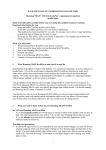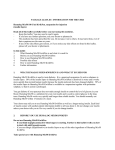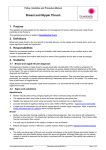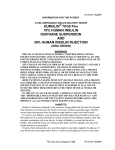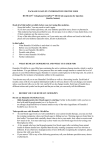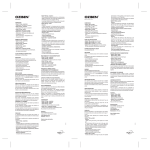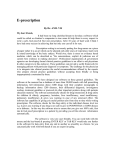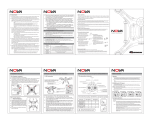Download HUMALOG KWIKPEN
Transcript
The format of this leaflet was determined by the Ministry of Health and its content was checked and approved in September 2011. HUMALOG KWIKPEN 1. NAME OF THE MEDICINAL PRODUCT Humalog 100 U/ml KwikPen, solution for injection 2. 2.1 QUALITATIVE AND QUANTITATIVE COMPOSITION General description Humalog KwikPen is a sterile, clear, colourless, aqueous solution. 2.2 Qualitative and quantitative composition One ml contains 100U (equivalent to 3.5mg) insulin lispro (recombinant DNA origin produced in E.coli). Each container includes 3ml equivalent to 300U insulin lispro. For a full list of excipients, see section 6.1. 3. PHARMACEUTICAL FORM Solution for injection. 4. CLINICAL PARTICULARS 4.1 Therapeutic indications For the treatment of adults and children with diabetes mellitus who require insulin for the maintenance of normal glucose homeostasis. Humalog KwikPen is also indicated for the initial stabilisation of diabetes mellitus. 4.2 Posology and method of administration The dosage should be determined by the physician, according to the requirement of the patient. Humalog may be given shortly before meals. When necessary Humalog can be given soon after meals. Humalog preparations should be given by subcutaneous injection or by continuous subcutaneous infusion pump (see section 4.2) and may, although not recommended, also be given by intramuscular injection. If necessary, Humalog may also be administered intravenously, for example; for the control of blood glucose levels during ketoacidosis, acute illnesses or during intra and post operative periods. Subcutaneous administration should be in the upper arms, thighs, buttocks, or abdomen. Use of injection sites should be rotated so that the same site is not used more than approximately once a month. When administered subcutaneously care should be taken when injecting Humalog KwikPen to ensure that a blood vessel has not been entered. After injection, the site of injection should not be massaged. Patients must be educated to use the proper injection techniques. Humalog KwikPen takes effect rapidly and has a shorter duration of activity (2 to 5 hours) given subcutaneously as compared with regular insulin. This rapid onset of activity allows a Humalog injection (or, in the case of administration by continuous subcutaneous infusion, a Humalog bolus) to be given very close to mealtime. The time course of action of any insulin may vary considerably in different individuals or at different times in the same individual. The faster onset of action compared to soluble human insulin is maintained regardless of injection site. As with all insulin preparations, the duration of action of Humalog KwikPen is dependent on dose, site of injection, blood supply, temperature, and physical activity. Humalog can be used in conjunction with a longer-acting human insulin or oral sulphonylurea agents, on the advice of a physician. Use of Humalog in an insulin infusion pump: Only certain CE-marked insulin infusion pumps may be used to infuse insulin lispro. Before infusing insulin lispro, the manufacturers instructions should be studied to ascertain the suitability or otherwise for the particular pump. Read and follow the instructions that accompany the infusion pump. Use the correct reservoir and catheter for the pump. Change the infusion set every 48 hours. Use aseptic technique when inserting the infusion set. In the event of a hypoglycaemic episode, the infusion should be stopped until the episode is resolved. If repeated or severe low blood glucose levels occur, notify your health care professional and consider the need to reduce or stop your insulin infusion. A pump malfunction or obstruction of the infusion set can result in a rapid rise in glucose levels. If an interruption to insulin flow is suspected, follow the instructions in the product literature and if appropriate, notify your health care professional. When used with an insulin infusion pump, Humalog should not be mixed with any other insulin. Intravenous administration of insulin: Intravenous injection of insulin lispro should be carried out following normal clinical practise for intravenous injections, for example by an intravenous bolus or by an infusion system. Frequent monitoring of the blood glucose levels is required. Infusion systems at concentrations from 0.1U/ml to 1.0U/ml insulin lispro in 0.9% sodium chloride or 5% dextrose are stable at room temperature for 48 hours. It is recommended that the system is primed before starting the infusion to the patient. 4.3 Contraindications Hypersensitivity to insulin lispro or to any of the excipients. Hypoglycaemia. 4.4 Special warnings and precautions for use Transferring a patient to another type or brand of insulin should be done under strict medical supervision. Changes in strength, brand (manufacturer), type (regular, NPH, lente, etc.), species (animal, human, human insulin analogue), and/or method of manufacture (recombinant DNA versus animal-source insulin) may result in the need for a change in dosage. For fast-acting insulins, any patient also on basal insulin must optimise dosage of both insulins to obtain glucose control across the whole day, particularly nocturnal/fasting glucose control. Conditions which may make the early warning symptoms of hypoglycaemia different or less pronounced include long duration of diabetes, intensified insulin therapy, diabetic nerve disease or medications such as beta-blockers. A few patients who have experienced hypoglycaemic reactions after transfer from animal-source insulin to human insulin have reported that the early warning symptoms of hypoglycaemia were less pronounced or different from those experienced with their previous insulin. Uncorrected hypoglycaemic or hyperglycaemic reactions can cause loss of consciousness, coma, or death. The use of dosages which are inadequate or discontinuation of treatment, especially in insulin-dependent diabetics, may lead to hyperglycaemia and diabetic ketoacidosis; conditions which are potentially lethal. Insulin requirements may be reduced in the presence of renal impairment. Insulin requirements may be reduced in patients with hepatic impairment due to reduced capacity for gluconeogenesis and reduced insulin breakdown; however, in patients with chronic hepatic impairment, an increase in insulin resistance may lead to increased insulin requirements. Insulin requirements may be increased during illness or emotional disturbances. Adjustment of dosage may also be necessary if patients undertake increased physical activity or change their usual diet. Exercise taken immediately after a meal may increase the risk of hypoglycaemia. A consequence of the pharmacodynamics of rapid-acting insulin analogues is that if hypoglycaemia occurs, it may occur earlier after an injection when compared with soluble human insulin. Humalog should only be used in children in preference to soluble insulin when a fast action of insulin might be beneficial. For example, in the timing of the injections in relation to meals. Combination of Humalog with pioglitazone: Cases of cardiac failure have been reported when pioglitazone was used in combination with insulin, especially in patients with risk factors for development of cardiac heart failure. This should be kept in mind, if treatment with the combination of pioglitazone and Humalog is considered. If the combination is used, patients should be observed for signs and symptoms of heart failure, weight gain and oedema. Pioglitazone should be discontinued, if any deterioration in cardiac symptoms occurs. 4.5 Interaction with other medicinal products and other forms of interaction Insulin requirements may be increased by medicinal products with hyperglycaemic activity, such as oral contraceptives, corticosteroids, or thyroid replacement therapy, danazol, beta2 stimulants (such as ritodrine, salbutamol, terbutaline). Insulin requirements may be reduced in the presence of medicinal products with hypoglycaemic activity, such as oral hypoglycemics, salicylates (for example, acetylsalicylic acid), sulpha antibiotics, certain antidepressants (monoamine oxidase inhibitors, selective serotonin reuptake inhibitors), certain angiotensin converting enzyme inhibitors (captopril, enalapril), angiotensin II receptor blockers, betablockers, octreotide or alcohol. The physician should be consulted when using other medications in addition to Humalog KwikPen (see section 4.4). 4.6 Fertility, pregnancy and lactation Data on a large number of exposed pregnancies do not indicate any adverse effect of insulin lispro on pregnancy or on the health of the foetus/newborn. It is essential to maintain good control of the insulin-treated (insulin-dependent or gestational diabetes) patient throughout pregnancy. Insulin requirements usually fall during the first trimester and increase during the second and third trimesters. Patients with diabetes should be advised to inform their doctor if they are pregnant or are contemplating pregnancy. Careful monitoring of glucose control, as well as general health, is essential in pregnant patients with diabetes. Patients with diabetes who are breast-feeding may require adjustments in insulin dose, diet or both. 4.7 Effects on ability to drive and use machines The patient’s ability to concentrate and react may be impaired as a result of hypoglycaemia. This may constitute a risk in situations where these abilities are of special importance (e.g. driving a car or operating machinery). Patients should be advised to take precautions to avoid hypoglycaemia whilst driving, this is particularly important in those who have reduced or absent awareness of the warning signs of hypoglycaemia or have frequent episodes of hypoglycaemia. The advisability of driving should be considered in these circumstances. 4.8 Undesirable effects Hypoglycaemia is the most frequent undesirable effect of insulin therapy that a patient with diabetes may suffer. Severe hypoglycaemia may lead to loss of consciousness, and in extreme cases, death. No specific frequency for hypoglycaemia is presented, since hypoglycaemia is a result of both the insulin dose and other factors e.g. a patient`s level of diet and exercise. Local allergy in patients is common (1/100 to <1/10). Redness, swelling, and itching can occur at the site of insulin injection. This condition usually resolves in a few days to a few weeks. In some instances, this condition may be related to factors other than insulin, such as irritants in the skin cleansing agent or poor injection technique. Systemic allergy, which is rare (1/10,000 to <1/1,000) but potentially more serious, is a generalised allergy to insulin. It may cause a rash over the whole body, shortness of breath, wheezing, reduction in blood pressure, fast pulse, or sweating. Severe cases of generalised allergy may be lifethreatening. Lipodystrophy at the injection site is uncommon (1/1,000 to <1/100). Cases of oedema have been reported with insulin therapy, particularly if previous poor metabolic control is improved by intensified insulin therapy. 4.9 Overdose Insulins have no specific overdose definitions because serum glucose concentrations are a result of complex interactions between insulin levels, glucose availability and other metabolic processes. Hypoglycaemia may occur as a result of an excess of insulin activity relative to food intake and energy expenditure. Hypoglycaemia may be associated with listlessness, confusion, palpitations, headache, sweating and vomiting. Mild hypoglycaemic episodes will respond to oral administration of glucose or other sugar or saccharated products. Correction of moderately severe hypoglycaemia can be accomplished by intramuscular or subcutaneous administration of glucagon, followed by oral carbohydrate when the patient recovers sufficiently. Patients who fail to respond to glucagon must be given glucose solution intravenously. If the patient is comatose, glucagon should be administered intramuscularly or subcutaneously. However, glucose solution must be given intravenously if glucagon is not available or if the patient fails to respond to glucagon. The patient should be given a meal as soon as consciousness is recovered. Sustained carbohydrate intake and observation may be necessary because hypoglycaemia may recur after apparent clinical recovery. 5. PHARMACOLOGICAL PROPERTIES 5.1 Pharmacodynamic properties Pharmacotherapeutic group : Fast-acting human insulin analogue, ATC code: A10A B04 The primary activity of insulin lispro is the regulation of glucose metabolism. In addition, insulins have several anabolic and anti-catabolic actions on a variety of different tissues. Within muscle tissue this includes increasing glycogen, fatty acid, glycerol and protein synthesis and amino acid uptake, while decreasing glycogenolysis, gluconeogenesis, ketogenesis, lipolysis, protein catabolism and amino acid output. Insulin lispro has a rapid onset of action (approximately 15 minutes), thus allowing it to be given closer to a meal (within zero to 15 minutes of the meal) when compared to regular insulin (30 to 45 minutes before). Insulin lispro takes effect rapidly and has a shorter duration of activity (2 to 5 hours) when compared to regular insulin. Clinical trials in patients with type 1 and type 2 diabetes have demonstrated reduced postprandial hyperglycaemia with insulin lispro compared to soluble human insulin. As with all insulin preparations, the time course of insulin lispro action may vary in different individuals or at different times in the same individual and is dependent on dose, site of injection, blood supply, temperature and physical activity. The typical activity profile following subcutaneous injection is illustrated below. Insulin lispro Humulin R Hypoglycemic Activity 0 1 2 3 4 5 6 Time (Hours) The above representation reflects the relative amount of glucose over time required to maintain the subject's whole blood glucose concentrations near fasting levels and is an indicator of the effect of these insulins on glucose metabolism over time. Clinical trials have been performed in children (61 patients aged 2 to 11) and children and adolescents (481 patients aged 9 to 19 years), comparing insulin lispro to human soluble insulin. The pharmacodynamic profile of insulin lispro in children is similar to that seen in adults. When used in subcutaneous infusion pumps, treatment with insulin lispro has been shown to result in lower glycosylated haemoglobin levels compared to soluble insulin. In a double-blind, crossover study, the reduction in glycosylated haemoglobin levels after 12 weeks dosing was 0.37 percentage points with insulin lispro, compared to 0.03 percentage points for soluble insulin (p = 0.004). In patients with type 2 diabetes on maximum doses of sulphonyl urea agents, studies have shown that the addition of insulin lispro significantly reduces HbA1c compared to sulphonyl urea alone. The reduction of HbA1c would also be expected with other insulin products e.g. soluble or isophane insulins. Clinical trials in patients with type 1 and type 2 diabetes have demonstrated a reduced number of episodes of nocturnal hypoglycaemia with insulin lispro compared to soluble human insulin. In some studies, reduction of nocturnal hypoglycaemia was associated with increased episodes of daytime hypoglycaemia. The glucodynamic response to insulin lispro is not affected by renal or hepatic function impairment. Glucodynamic differences between insulin lispro and soluble human insulin, as measured during a glucose clamp procedure, were maintained over a wide range of renal function. Insulin lispro has been shown to be equipotent to human insulin on a molar basis but its effect is more rapid and of a shorter duration. 5.2 Pharmacokinetic properties The pharmacokinetics of insulin lispro reflect a compound that is rapidly absorbed, and achieves peak blood levels 30 to 70 minutes following subcutaneous injection. When considering the clinical relevance of these kinetics, it is more appropriate to examine the glucose utilisation curves (as discussed in 5.1). Insulin lispro maintains more rapid absorption when compared to soluble human insulin in patients with renal impairment. In patients with type 2 diabetes over a wide range of renal function the pharmacokinetic differences between insulin lispro and soluble human insulin were generally maintained and shown to be independent of renal function. Insulin lispro maintains more rapid absorption and elimination when compared to soluble human insulin in patients with hepatic impairment. 5.3 Preclinical safety data In in vitro tests, including binding to insulin receptor sites and effects on growing cells, insulin lispro behaved in a manner that closely resembled human insulin. Studies also demonstrate that the dissociation of binding to the insulin receptor of insulin lispro is equivalent to human insulin. Acute, one month and twelve month toxicology studies produced no significant toxicity findings. Insulin lispro did not induce fertility impairment, embryotoxicity or teratogenicity in animal studies. 6. PHARMACEUTICAL PARTICULARS 6.1 List of excipients metaCresol [3.15 mg/ml] Glycerol Dibasic sodium phosphate. Zinc oxide Water for injections Hydrochloric acid and sodium hydroxide maybe used to adjust pH to 7.0 – 7.8. 6.2 Incompatibilities Humalog preparations should not be mixed with insulins produced by other manufacturers or with animal insulin preparations. 6.3 Shelf life Unused pre-filled pens 3 years. After first use 28 days. 6.4 Special precautions for storage Unused pre-filled pens Store in a refrigerator (2°C - 8°C). Do not freeze. Do not expose to excessive heat or direct sunlight. After first use Store below 30°C. Do not refrigerate. The pre-filled pen should not be stored with the needle attached. 6.5 Nature and contents of container and special equipment for use, administration or implantation The solution is contained in type I flint glass cartridges, sealed with butyl or halobutyl disc seals and plunger heads and are secured with aluminium seals. Dimeticone or silicone emulsion may be used to treat the cartridge plunger, and/or the glass cartridge. The 3 ml cartridges are sealed in a disposable pen injector, called the “KwikPen”. Needles are not included. Not all packs may be marketed. 5 x 3 ml Humalog 100 U/ml KwikPens 6.6 Special precautions for disposal and other handling Any unused product or waste material should be disposed of in accordance with local requirements. Instructions for use and handling Inspect the Humalog solution. It should be clear and colourless. Do not use Humalog if it appears cloudy, thickened, or slightly coloured or if solid particles are visible. a) Handling of the pre-filled pen Before using the KwikPen the user manual included in the package leaflet must be read carefully. The KwikPen has to be used as recommended in the user manual. b) Mixing insulins Do not mix insulin in vials with insulin in cartridges. See section 6.2. 7. MANUFACTURER Lilly France, S.A.S F-67640 Fegersheim, France 8. LICENSE HOLDER Eli Lilly Israel Ltd., P.O.Box 2160 Herzliya 46120. X KWIK 02








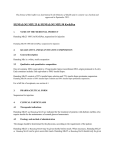
![TEMPLATE No1 [CPMP positive opinion full application]](http://vs1.manualzilla.com/store/data/005681628_1-1a3acb54fcca990dd8c826546eb4788f-150x150.png)
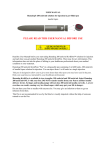

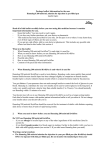
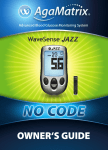
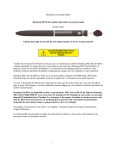
![[Product Monograph Template - Standard]](http://vs1.manualzilla.com/store/data/005786637_1-bbde87d0b5b85ef8c8ff6a7fd943fd08-150x150.png)
